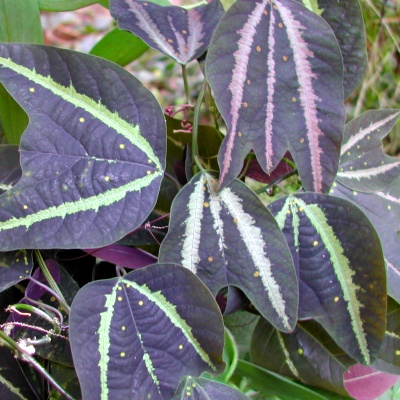Passiflora boenderi
Note -- It is normal for a few leaves to drop during shipping. Once the plant has settled down, it will quickly regrow more. Pot size -- You may transfer your plant to a 1 to 3 gallon container, which should hold it for a few months. It may eventually need a 5 gallon container, depending on how large you choose to let it grow. You may keep it in a 2-3 gallon pot if you prune it back once in a while. Soil -- Like most Passifloras, this one likes moist soil that drains well. A typical mix is 2 parts potting soil to 1 part perlite or coarse horticultural sand. An alternate mix is 1 part coir fiber to 1 part perlite, with some slow-release fertilizer added. Transplanting -- Avoid letting the soil ball break apart when repotting, which can damage the roots. Watering the soil before repotting can help keep it together. After repotting, don't compress the soil down, and give no liquid fertilizer or direct sun the first week after transplanting. Watering -- Aim to keep the soil evenly moist (but not soggy) most of the time. Do not let the soil dry out completely. You may use a moisture meter probe to monitor the moisture levels deep in the root zone. If your tap water is very "hard", meaning high in minerals, i recommend using bottled water or rain water. Most water filters do not remove minerals. Temperature & humidity -- This species is happiest above 60 degrees F. It reportedly does not do well below 50 degrees, and probably can't survive frost. Over about 40% humidity is recommended. If the air indoors gets too dry, consider using an ultrasonic humidifier, which you can buy at home improvement stores and thrift stores inexpensively. Lighting -- It seems to prefer bright, indirect light or dappled sun. I don't know how much prolonged, direct sun it can handle. It does not need a lot of light to thrive, but the variegation may appear fainter in dim lighting. Trellising -- Give your plant something to climb on, like a trellis or wires. You may use twist-ties to train it horizontally or vertically, or both. You can prune your vine if it gets too long - just avoid removing too many branches at one time. Fertilizing -- Feed about every 2 months with a slow-release (pelleted or organic) fertilizer. It's normal for an older leaf to occasionally turn yellow and drop, but if it seems excessive, the plant may need more nitrogen fertilizer. Or the soil may be too dry down in the root zone. Pests to watch for -- spider mites (tiny "dots" under the leaves + webbing), mealy bugs, scale (brown discs on the stems or leaves). Have fun with it! - Jeff Strange Wonderful Things
|
|||||||||


